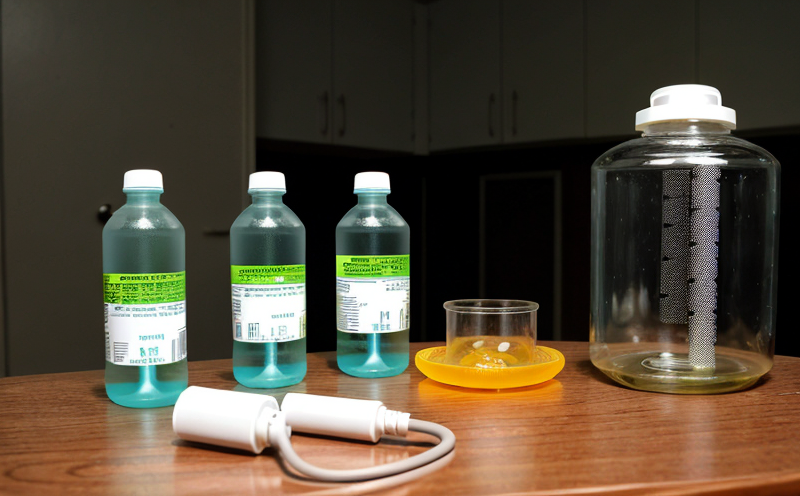ISO 18589-6 Uranium Determination Test in Water
The ISO 18589-6 standard provides a robust and standardized method for determining uranium content in water, which is essential for ensuring compliance with environmental regulations. This test is particularly critical in sectors like municipal water treatment, nuclear waste management, and environmental monitoring where the presence of uranium can pose significant risks to public health and ecological balance.
The uranium determination involves several key steps including sample collection, pretreatment, digestion, separation, and detection using spectroscopic techniques such as ICP-MS (Inductively Coupled Plasma Mass Spectrometry). The method described in ISO 18589-6 ensures that the results are accurate, precise, and reproducible across different laboratories. This is achieved through stringent control of all parameters involved in sample preparation and analysis.
The importance of this test cannot be overstated given its role in safeguarding water quality standards set by various regulatory bodies around the world. By adhering to ISO 18589-6, laboratories can provide reliable data that helps stakeholders make informed decisions regarding water safety measures.
For instance, uranium contamination could lead to severe health issues if not managed properly; hence continuous monitoring is crucial. The standard also emphasizes the need for regular calibration of instruments used during analysis to ensure accurate measurements every time. Compliance with these standards demonstrates a commitment to excellence and reliability in analytical services provided by reputable labs.
In summary, conducting an ISO 18589-6 Uranium Determination Test ensures compliance with international norms while providing trustworthy data needed for effective management practices concerning water safety.
Benefits
The implementation of the ISO 18589-6 standard offers numerous advantages to organizations involved in water testing and related industries. One major benefit is enhanced accuracy and precision, which are critical when dealing with minute concentrations of uranium in complex matrices like natural waters or treated wastewater.
By using this internationally recognized method, laboratories can achieve consistent results across multiple batches and sites, thereby increasing confidence among clients about the reliability of test outcomes. This consistency also facilitates easier comparison between different datasets collected over extended periods.
Achieving ISO certification not only enhances credibility but also opens up new market opportunities domestically and internationally as it aligns with global standards. It demonstrates a high level of competence in analytical chemistry, which is highly valued by clients seeking assurance that their testing procedures meet the highest quality benchmarks.
Furthermore, compliance with this standard helps mitigate risks associated with non-compliance penalties or reputational damage due to inaccurate measurements. By ensuring robust methodologies and rigorous quality control measures, organizations can avoid costly mistakes and maintain a strong brand reputation.
International Acceptance and Recognition
The ISO 18589-6 standard enjoys widespread recognition among regulatory authorities worldwide who mandate its use for uranium determination in water. Its acceptance extends beyond mere compliance requirements; it is often seen as a benchmark for excellence in analytical chemistry.
Countries such as the United States, Canada, European Union members, and others have adopted or referenced this standard in their national laws and regulations governing environmental protection. This global consensus underscores its significance in establishing uniformity and consistency when dealing with uranium contamination issues.
Recognized international bodies like the World Health Organization (WHO) utilize ISO 18589-6 as part of their guidelines for setting safe drinking water standards, further emphasizing its importance within public health frameworks. Similarly, organizations responsible for managing nuclear facilities frequently rely on this standard to ensure operational safety and regulatory compliance.
Adopting ISO 18589-6 demonstrates a commitment to upholding high ethical standards in scientific research and practice. It reassures stakeholders that rigorous quality assurance protocols are being followed throughout the entire testing process from sample collection through final analysis.
Use Cases and Application Examples
| Application | Description |
|---|---|
| Municipal Water Treatment Plants | Detecting uranium levels in source waters before treatment to prevent contamination of treated water supplies. |
| Nuclear Power Plant Operations | Monitoring uranium concentrations post-treatment to ensure they fall within acceptable limits as specified by regulatory bodies. |
| Environmental Monitoring Agencies | Conducting periodic surveys in areas known or suspected of having high levels of natural uranium deposits. |
| Agricultural Water Quality Control Programs | Ensuring that irrigation waters do not exceed safe thresholds for uranium to protect crops and livestock health. |
| Research Institutions Studying Uranium Contamination Effects | Investigating the long-term impacts of low-level uranium exposure on ecosystems and human populations. |
| Private Water Testing Laboratories Providing Public Services | Offering clients peace of mind by providing accurate, consistent measurements that comply with international standards. |
| Regulatory Bodies Setting Drinking Water Quality Standards | Using this method to establish and monitor compliance with strict limits on uranium content in potable water sources. |
| Natural Resource Exploration Companies Assessing Environmental Impact | Evaluating potential risks associated with mining activities that may release uranium into surface waters. |
These real-world applications highlight the versatility and necessity of ISO 18589-6 in addressing various aspects related to water quality assessment, particularly focusing on uranium contamination. Each case showcases how adherence to this standard contributes towards safer environments and better decision-making processes.





